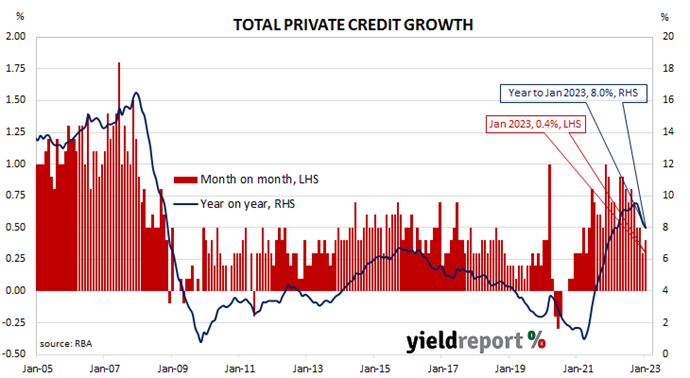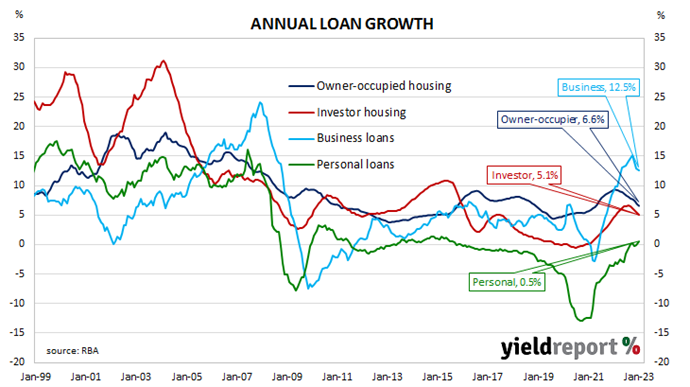Summary: Private sector credit up 0.4% in January, greater than expected; annual growth rate down from 8.3% to 8.0%; softest period since start of 2021; bond yields down, rate-rise expectations soften; Westpac: “sharp economic slowdown” will add to slowing of credit demand; business lending accounts for nearly 50% of net growth, owner-occupier lending for nearly 45%.
The pace of lending to the non-bank private sector by financial institutions in Australia followed a steady-but-gradual downtrend from late-2015 through to early 2020 before hitting what appears to be a nadir in March 2021. That downtrend ended later in the same year and annual growth rates have only recently declined below the peak seen in the previous decade.
According to the latest RBA figures, private sector credit increased by 0.4% in January. The result was greater than the 0.3% increase which had been generally expected as well as December’s 0.3% rise. However, on an annual basis, the growth rate slowed from 8.3% to 8.0%.
“The results of the past two months represent the softest two month period since the start of 2021,” said Westpac senior economist Andrew Hanlan.
Commonwealth Government bond yields moved lower on the day. By the close of business, the 3-year ACGB yield had shed 4bps to 3.61%, the 10-year yield had lost 2bps to 3.86% while the 20-year yield finished 1bp lower at 4.17%.
In the cash futures market, expectations regarding future rate rises softened. At the end of the day, contracts implied the cash rate would rise from the current rate of 3.32% to average 3.505% in March and then increase to an average of 3.935% through May. August 2023 contracts implied a 4.24% average cash rate while November 2023 contracts implied 4.275%.
Hanlan expects slower private loan growth in the wake of higher interest rates but also expects the Australian economy in general to play a part. “More generally, a sharp economic slowdown is in prospect for the Australian economy in 2023, which will reinforce the slowing in demand for credit.”
Business lending accounted for just under 50% of the net growth over the month. Owner-occupier lending accounted for nearly 45% and investor lending accounted for most of the balance.
The traditional driver of overall loan growth, the owner-occupier segment, grew by 0.4% over the month, the same growth rate as in December and November. The sector’s 12-month growth rate slowed again, this time from 6.9% to 6.6%.
Total lending in the business sector increased by 0.5%, up from the 0.3% increase recorded in the previous month. Growth on an annual basis slowed from 12.9% to 12.5%.
Monthly growth in the investor-lending segment slowed to a near-halt in early 2018 and essentially stayed that way until mid-2021. In January, net lending grew by 0.2%, the same rate as in December and the 12-month growth rate slowed from 5.5% to 5.1%.
Total personal loans increased by 0.1%, in contrast to December’s -0.5%, taking the annual contraction rate from -0.1% to 0.5%. This category of debt includes fixed-term loans for large personal expenditures, credit cards and other revolving credit facilities.



